Soviet SAU against German tanks. Part 1
This publication attempts to analyze the anti-tank capabilities of the Soviet self-propelled artillery mounts (SAU), which were available in the USSR during the Great Patriotic War. By the beginning of the hostilities in June 1941, there were practically no self-propelled artillery installations in the Red Army, although work to create them was carried out since the first half of the 30s. Brought into the USSR to the stage of mass production, SAUs were created on the basis of artillery systems with low ballistics and were considered as means of supporting infantry units. The 76-mm regimental guns of the 1927 model and the 122-mm howitzer of the 1910 / 30 model were used as weapons of the first Soviet self-propelled guns.
The first Soviet serial model of the ACS was the SU-12 on the chassis of a three-axle American truck "Morland" (Moreland TX6) with two driving axles. On the cargo platform "Morland" was mounted thumbs installation with 76-mm regimental gun. “Cargo self-propelled guns” entered service in the 1933 year and were first demonstrated at the parade in the 1934 year. Shortly after the start of serial production in the USSR of GAZ-AAA trucks on their basis, the assembly of SAU SU-1-12 began. According to archive data, a total of 99 ACS SU-12 / SU-1-12 was built. Of these, 48 based on the Moreland truck and 51 based on the Soviet truck GAZ-AAA.
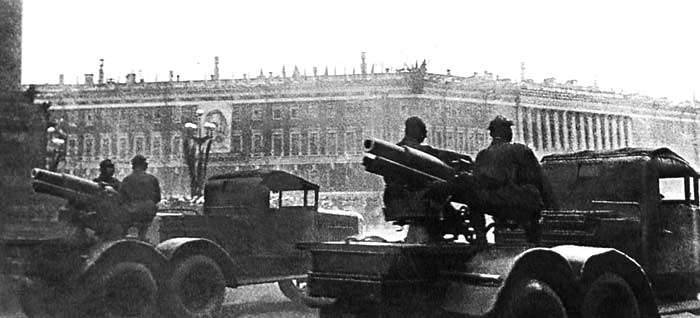
Initially, the SU-SU-12 SAU did not have any kind of armor protection at all, but soon a U-shaped armor shield was installed to prevent the calculation from bullets and fragments. Gun ammunition was 36 shrapnel and fragmentation grenades, armor-piercing shells were not provided. The rate of fire was 10-12 rds / min. The installation of the gun on the platform of the truck made it possible to quickly and inexpensively create an improvised ACS. Tumb artillery system had a sector of shelling 270 degrees, the fire from the gun could be carried out both straight-back and on board. There was also a fundamental possibility of shooting on the move, but at the same time the accuracy was greatly reduced.
The mobility of the SU-12 when traveling on good roads was significantly higher than that of the 76-mm regimental guns mounted on horse-drawn trades. However, the shortcomings of the first Soviet self-propelled gun was a lot. The vulnerability of the artillery crew, partially covered with 4-mm steel shield, was very high in direct fire. The passability of the wheeled vehicle on weak grounds left much to be desired and was seriously inferior to the horse teams of the regimental and divisional artillery. To pull out the wheel self-propelled gun which has got stuck in dirt it was possible only a tractor. In this regard, it was decided to build self-propelled guns on tracked chassis, and the production of the SU-12 stopped in the 1935 year.
The first Soviet self-propelled guns were successfully used in combat operations in the Far East against the Japanese at the end of the 30s and in the Winter War with Finland. All SU-12, available in the western part of the country, were lost shortly after the German attack, without affecting the course of hostilities.
In 20-30, the creation of self-propelled guns based on trucks was a global trend, and this experience in the USSR turned out to be useful. But if the installation of anti-aircraft guns on trucks made sense, then for ACS operating in the immediate vicinity of the enemy, the use of an unprotected road chassis with limited cross-country ability was certainly a dead-end solution.
In the prewar period, a number of self-propelled guns were created in the Soviet Union based on light tanks. As carriers of the 45-mm anti-tank guns, the T-37A floating wedges were considered, but the matter was limited to the construction of two prototypes. It was possible to bring the self-propelled guns SU-5-2 to the stage of mass production with a 122-mm howitzer mod. 1910/30 based on the T-26 tank. SU-5-2 were produced in a small series from 1936 to 1937, a total of 31 cars were built.
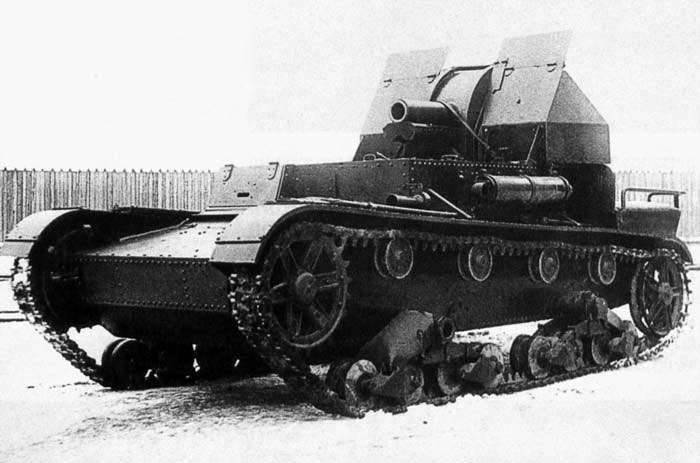
Ammunition 122-mm SAU SU-5-2 was 4 projectile and 6 charges. Horizontal pointing angles are 30 °, vertically from 0 ° to + 60 °. The maximum initial velocity of a fragmentation projectile is 335 m / s, the maximum firing range is 7680 m, the rate of fire of 5 — 6 shots / min. The thickness of the frontal armor - 15 mm, board and feed - 10 mm, that is, the armor was quite adequate to withstand bullets and shrapnel, but it was only in front and partly on the sides.
In general, the SU-5-2 for its time had good fighting qualities, which was confirmed during the fighting at Lake Hassan. The reports of the command of the Red Army 2 Mechanized Brigade noted:
Due to the small number of 76-mm SU-12 and 122-mm SU-5-2 did not have a significant impact on the course of hostilities in the initial period of the war. The anti-tank capabilities of the 76-mm SU-12 were low, with an increased vulnerability of both the SPG itself and the calculation for bullets and shrapnel. With an initial speed of 76-mm blunt-headed BR-350А - 370 m / s armored-piercing projectile at an angle of 500 °, he punched 90 mm armor, which allowed him to fight only with light German tanks and armored vehicles. Before the appearance in the ammunition of regimental guns of cumulative shells, their anti-tank capabilities were very modest.
Despite the fact that there were no armor-piercing shells in the 122-mm howitzer ammunition, the high-explosive fragmentation grenades were often quite effective. So, with the weight of the projectile 53-OF-462 - 21,76 kg, it contained 3,67 kg of TNT, which in the 1941 year, with a direct hit, guaranteed to hit any German tank. When the projectile was broken, heavy debris was formed that could penetrate armor with a thickness of up to 20 mm within a radius of 2-3 meters. This was quite enough to destroy the armor of armored personnel carriers and light tanks, as well as disabling the undercarriage, observation devices, sights and weapons. That is, with the correct tactics of use and the presence in the troops of a significant number of SU-5-2, these SAUs in the initial period of the war could fight not only with fortifications and infantry, but also with German tanks.
Before the war in the USSR, an SAU with a high anti-tank potential had already been created. In the 1936, the test was conducted by the SU-6, armed with an 76-mm anti-aircraft gun 3-K on the chassis of a light tank T-26. This machine was designed for anti-aircraft maintenance of mechanized columns. She did not arrange the military, since the entire calculation did not fit in an artillery installation, and the installer of the remote tubes was forced to move around in an escort vehicle.
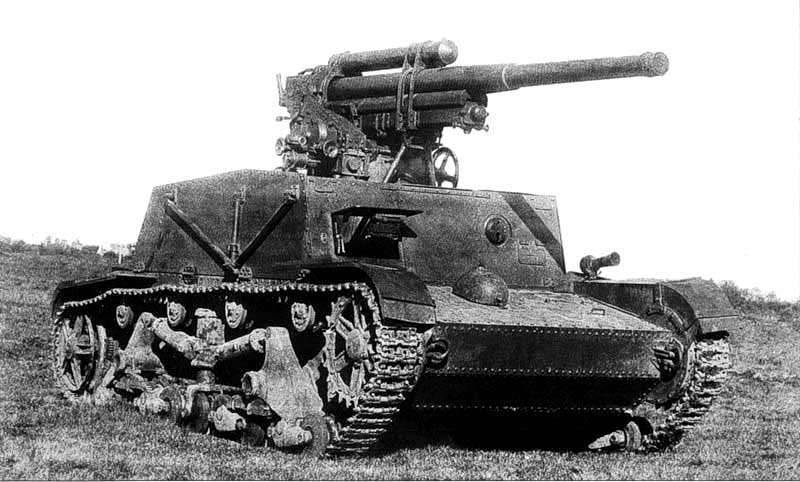
Not too successful as an anti-aircraft gun, the ACS SU-6 could become a very effective anti-tank weapon, operating from pre-arranged positions and ambushes. The BR-361 armor-piercing projectile, released from the 3-K gun at a distance of 1000 meters at a meeting angle of 90 °, pierced 82-mm armor. In 1941-1942, the capabilities of the 76-mm ACS SU-6 allowed her to successfully fight with any German tanks at actual shooting distances. When using sub-caliber shells, armor penetration rates would be much higher. Unfortunately, the SU-6 did not enter service as an anti-tank self-propelled artillery installation (PT SAU).
Many researchers refer to the heavy assault SAU tank KV-2. Formally, due to the presence of a rotating turret, the KV-2 is identified as a tank. But in fact, the combat vehicle, armed with a unique 152-mm tank howitzer arr. 1938 / 40 (M-10T), in many respects was the ACS. The M-10T howitzer was vertically induced in the range from −3 to + 18 °, with a fixed position of the tower it could be induced in a small sector of horizontal pickup, which was typical of self-propelled installations. Ammunition was 36 shots of separate-cartridge loading.
KV-2 was created based on the experience of dealing with Finnish pillboxes on the “Mannerheim Line”. The thickness of the frontal and side armor was 75 mm, and the thickness of the armor of the gun was 110 mm, which made it low-vulnerable for anti-tank guns of the 37-50-mm caliber. However, the high security of the KV-2 was often depreciated by low technical reliability and poor training of driver mechanics.
With a B-2K-500 hp diesel engine, the 52-ton car on the highway could theoretically accelerate to 34 km / h. In reality, the speed of a good road did not exceed 25 km / h. Cross-country tank moved with the speed of a pedestrian 5-7 km / h. Considering that the KV-2’s passability on weak soils was not very good, and it was not easy to pull a tank stuck in the mud, we had to choose the route of movement very carefully. Due to excessive weight and size, crossing over water barriers often became an insoluble task, bridges and crossings could not stand, and many KV-2s were simply abandoned during the retreat.
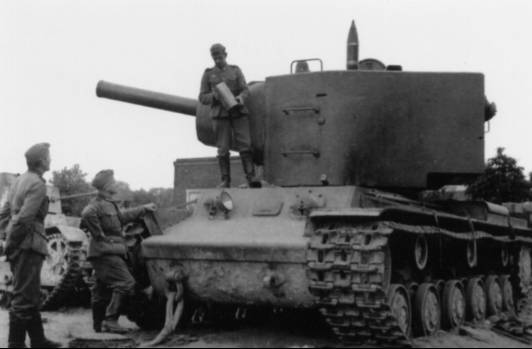
22 June 1941 of the KV-2 ammunition unit had only high-explosive fragmentation grenades of the RP-530 weighing 40 kg, containing about 6 kg of trotyl. The hit of such a projectile in any German tank in 1941 inevitably turned it into a pile of burning scrap metal. In practice, in view of the impossibility of manning the ammunition with standard ammunition, all the shells of the M-10 towed howitzer were used for firing. In this case, the required number of beams of gunpowder was removed from the liner. Cast iron fragmentary howitzer grenades, incendiary projectiles, old high-explosive grenades and even shrapnel, delivered to blow, were used. When firing at German tanks, concrete-shells showed good results.
The M-10T had a whole range of flaws that devalued its effectiveness on the battlefield. Due to the imbalance of the tower, a regular electric motor could not always cope with its weight, which made the rotation of the tower a very difficult task. Even with a small angle of inclination of the tank, it was often impossible to turn the tower. Due to excessive recoil, the gun could only be fired during a full stop of the tank. The recoil of the gun could simply disable both the turret turning mechanism and the engine-transmission group, and this despite the fact that shooting at full charge was strictly forbidden from the M-10T tank. The practical rate of fire with the adjustment of aiming was 2 rounds per minute, which, in combination with a low turret rotation speed and a relatively small direct shot range, reduced anti-tank capabilities.
Because of all this, the combat effectiveness of the machine created for offensive operations and the destruction of enemy fortifications, when fired at direct fire from a distance of several hundred meters, turned out to be low. However, most of the KV-2 was lost not in duels with German tanks, but as a result of damage from German artillery fire, strikes from diving bombers, engine breakdowns, transmission and undercarriage, and lack of fuel and lubricants. Shortly after the start of the war, the production of the KV-2 was minimized. In total, from January 1940 to July 1941, the company managed to build 204 machines.
In the initial period of the war, a significant number of damaged and defective T-26 light tanks of various modifications accumulated at tank repair plants. Often, tanks had damage to the tower or weapons, which prevented their further use. Also, two-turreted tanks with machine-gun armament demonstrated their complete inconsistency. Under these conditions, it seemed logical to rework tanks with defective or outdated armament in SAU. It is known that a certain number of vehicles with dismantled turrets were reequipped with 37 and 45-mm anti-tank guns with armor shields. According to archival documents, such SAUs, for example, were available in October 1941 of the year in the 124-th tank brigade, but the images of the machines were not preserved. In firepower, the improvised self-propelled guns did not outperform T-26 tanks with 45-mm guns, inferior in crew security. But the advantage of such machines was a much better overview of the battlefield, and in the conditions of the catastrophic losses of the first months of the war, any combat-ready armor was worth its weight in gold. With proper tactics using 37 and 45-mm self-propelled guns in 1941, they could quite successfully fight with enemy tanks.
In the autumn of 1941, at the Kirov Leningrad Plant, self-propelled guns armed with 26-mm QD guns were manufactured on the repaired T-76 chassis. This gun was a tank version of the 76-mm regimental gun model 1927 g., With similar ballistics and ammunition. In different sources, the data self-propelled designated differently: T-26-SU, SU-T-26, but most often SU-76P or SU-26. The gun SU-26 had a circular attack, the calculation in front was covered with broneschit.
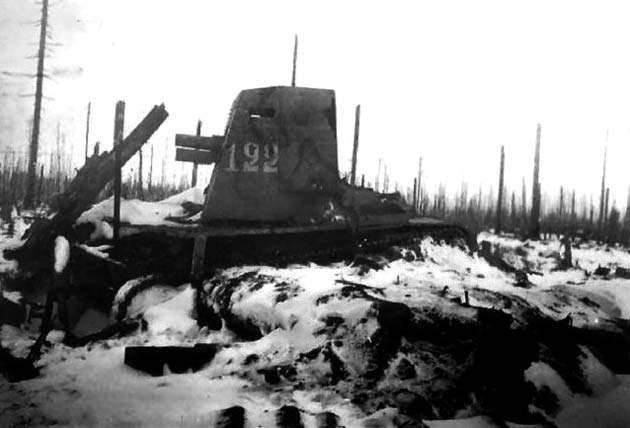
Later versions, built in 1942 year, also had armored protection on the sides. According to archival data, in Leningrad during the war years 14 ACS SU-26 was built, some of them survived to break the blockade. Of course, the anti-tank potential of these self-propelled guns was very weak, and they were used mainly for artillery support of tanks and infantry.
ZIS-30, armed with an 57-mm anti-tank gun, was the first Soviet specialized anti-tank gun. 1941 d. Very often this tool is called ZIS-2, but this is not quite correct. From VET ZIS-2, whose production was resumed in 1943 year, 57-mm gun arr. 1941 was different in a number of parts, although in general the design was the same. Anti-tank 57-mm guns had excellent armor penetration and at the beginning of the war guaranteed to penetrate the frontal armor of any German tank.
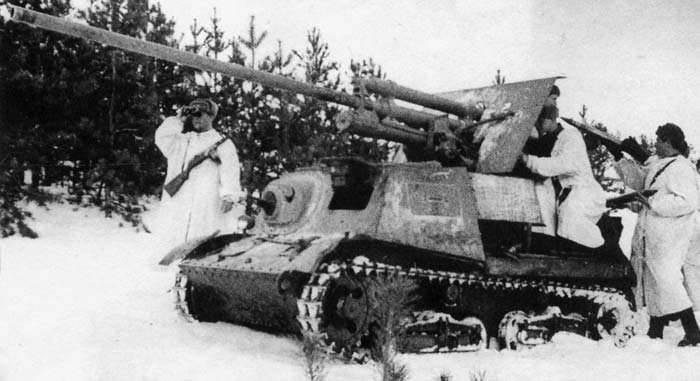
PT SAU ZIS-30 was a lightweight anti-tank unit with an open weapon. The upper machine gun was mounted in the middle part of the body of the light tractor T-20 "Komsomolets". Vertical pickup angles ranged from -5 to + 25 °, along the horizon - in the 30 ° sector. Practical rate of fire reached 20 rds / min. From bullets and fragments, the calculation, consisting of a 5 man, in a battle was defended only by a gun shield. The fire from the gun could only be conducted from a place. Due to the high center of gravity and strong recoil, it was necessary to fold openers in the rear part of the ACS in order to avoid overturning. For self-defense self-propelled installation had a 7,62-mm machine gun DT, inherited from the tractor Komsomolets.
Serial production of ZIS-30 automatic control systems began at the end of September 1941 at the Nizhny Novgorod machine-building plant and lasted only about a month. During this time, managed to build a self-propelled 101. According to the official version, the production of ZIS-30 was discontinued due to the absence of Komsomolets tractors, but even if this is so, what prevented the installation of very anti-tank 57-mm guns on the chassis of light tanks?
The most likely reason for the collapse of the construction of 57-mm PT SAU, most likely, were difficulties with the production of gun barrels. The percentage of defects in the manufacture of trunks reached completely indecent values, and it was impossible to correct this situation on the existing machine park, despite the efforts of the workforce of the manufacturer. This, and not the "excess power" of 57-mm anti-tank guns, explains their insignificant production volumes in the 1941 year and the subsequent failure of serial construction. Gorky Artillery Plant number 92, and the very VG Grabin was easier, based on the design of 57-mm guns arr. 1941, to manufacture the divisional 76-mm gun, which became widely known as ZIS-3. The 76-mm divisional gun of the 1942 model of the year (ZIS-3) at the time of creation had quite acceptable armor penetration, while possessing a more powerful high-explosive fragmentation projectile. Subsequently, this weapon became widespread and was popular with the troops. ZIS-3 was in service not only in divisional artillery, specially modified weapons were used by fighter-anti-tank units and installed on self-propelled gun mounts. Subsequently, the production of 57-mm VET after making some changes in the design under the name ZIS-2 was resumed in 1943 year. This became possible after receiving a perfect machine park from the USA, which made it possible to solve the problem with the manufacture of barrels.
As for the ZIS-30 ACS, this self-propelled gun in the conditions of an acute shortage of anti-tank weapons initially proved itself well. The gunners, who had previously dealt with 45-mm anti-tank guns, especially liked the high armor penetration and direct shot range. During combat use in self-propelled guns revealed a number of serious shortcomings: overloaded chassis, insufficient power reserve, small ammunition and a tendency to overturn. However, all this was quite predictable, since the ZIS-30 self-propelled guns were a typical ersatz — a model of wartime created in a hurry from the available undercarriage chassis and artillery units. By the middle of 1942, almost all ZIS-30 were lost during the fighting. Nevertheless, they proved to be a very useful means of fighting German tanks. The ZIS-30 self-propelled guns were armed with anti-tank batteries of tank brigades of the Western and South-Western fronts and took an active part in the defense of Moscow.
After the stabilization of the situation on the front and a number of successful offensive operations of the Red Army, there was an urgent need for self-propelled guns with artillery support. Unlike tanks, self-propelled guns should not have been directly involved in the attack. Moving at a distance of 500-600 meters from the advancing troops, they used fire of their guns to suppress the firing points, destroyed the fortifications and destroyed the enemy infantry. That is, a typical "art shurm" was required, if you use the terminology of the enemy. This made different demands on the ACS compared to tanks. Security self-propelled guns could be less, but it was preferable to increase the caliber of guns, and, as a consequence, the power of the projectiles.
Late in the fall of 1942, the production of the SU-76 began. This self-propelled gun was created on the basis of light tanks T-60 and T-70 using a number of automotive units and armed with 76-mm gun ZIS-ZSh (Sh - assault) - specially developed for SAU version of the division gun. Vertical pickup angles ranged from -3 to + 25 °, along the horizon - in the 15 ° sector. The elevation angle of the gun made it possible to reach the firing range of the ZIS-3 divisional gun, that is, 13 km. Ammunition was 60 shells. The thickness of the frontal armor - 26-35 mm, onboard and stern -10-15 mm allowed to protect the crew (4 man) from small arms and debris. The first serial modification also had an armored 7 mm roof.
The power plant SU-76 was a pair of two automotive engines GAZ-202 with a total power of 140 hp. According to the designers, this was supposed to reduce the cost of production of ACS, but caused mass complaints from the army. The power plant was very difficult to control, asynchronous operation of the engines caused strong torsional vibrations, which led to a rapid failure of the transmission.
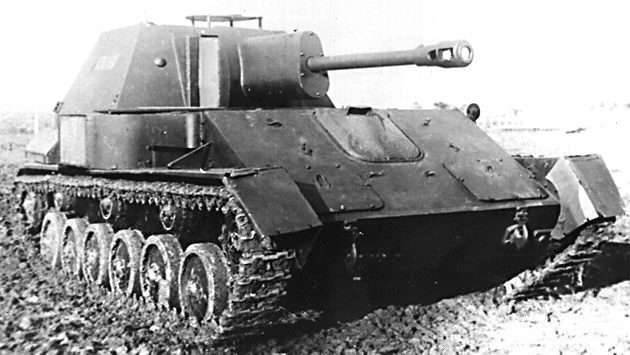
The first 25 units made in SU-76 in January 1943 were sent to a training self-propelled artillery regiment. A month later, the first two self-propelled artillery regiments (SAP) formed on the SU-76 set off for the Volkhov front and took part in breaking through the blockade of Leningrad. During the fighting, self-propelled guns demonstrated good mobility and maneuverability. The firepower of the guns made it possible to effectively destroy light field fortifications and destroy the enemy's manpower. But at the same time there was a massive failure of the transmission elements and engines. This led to a halt in serial production after the release of 320 machines. Refinement of the engine compartment did not lead to a radical change in design. To increase reliability, it was decided to strengthen its elements in order to increase reliability and increase service life. Subsequently, the power of the twin engine was brought to 170 HP. In addition, they abandoned the armored roof of the crew compartment, which made it possible to reduce the mass from 11,2 to 10,5 t. And improved crew working conditions and visibility. In the stowed position to protect against road dust and precipitation, the fighting compartment was covered with a tarpaulin. This version of the ACS, which received the designation SU-76M, managed to take part in the Battle of Kursk. Understanding that the SAU is not a tank, to many commanders did not come immediately. Attempts to use SU-76М with anti-bullet armor in frontal attacks of well-fortified enemy positions inevitably led to heavy losses. It was then that this self-propelled gun deserved among the front-line soldiers unflattering nicknames: “bitch”, “naked ferdinand” and “fraternal grave of the crew”. However, with proper use of SU-76M showed themselves well. In defense, they repelled infantry attacks and were used as a protected mobile anti-tank reserve. In the offensive, self-propelled guns suppressed machine-gun nests, destroyed pillboxes and bunkers, made artillery fire with passes in wire barriers, and, if necessary, fought against counterattacking tanks.
In the second half of the war, the 76-mm armor-piercing projectile was no longer guaranteed to hit the German medium tanks Pz. IV late modifications and heavy Pz. V Panther and Pz. VI "Tiger", and shooting cumulative projectiles used in regimental guns, because of the unreliable operation of the fuses and the possibility of rupture in the barrel for divisional and tank guns was strictly prohibited. This problem was resolved after the introduction of the 53-UBR-354P shot with the 53-BR-350П sabot. A X-rayed projectile at a distance of 500 meters pierced the 90 mm normal armor, which made it possible to confidently hit the frontal armor of the German fours, as well as the side of the Tigers and Panthers. Of course, SU-76М was not suitable for duels with tanks and anti-tank self-propelled guns of the enemy, which, since 1943, were completely armed with long-barreled guns with high ballistics. But with actions from ambushes, various kinds of shelters and in street battles, the chances were quite good. Good mobility and high permeability on weak soils also played a role. Proper use of camouflage, taking into account the terrain, as well as maneuvering from one shelter to another, is often allowed to achieve victory even over the enemy’s heavy tanks. The demand for the SU-76М as a universal means of artillery escort of infantry and tank units is confirmed by the huge circulation - 14 292 built vehicles.
At the very end of the war, the role of the 76-mm self-propelled guns as a means of fighting the enemy’s armored vehicles was reduced. By the time our troops were already quite saturated with specialized anti-tank guns and anti-tank guns, and enemy tanks became rare. During this period, the SU-76M was used exclusively for its intended purpose, as well as an armored personnel carrier for the transport of infantry, the evacuation of the wounded, and as vehicles of advanced artillery observers.
At the beginning of 1943 of the year on the basis of captured German tanks Pz. Kpfw III and ACS StuG III began production of ACS SU-76I. In terms of security, with almost identical characteristics of weapons, they are significantly superior to the SU-76. The thickness of the frontal armor of captured machines, depending on the modification, was 30-60 mm. The forehead of the conning tower and sides were defended with 30 mm armor, the thickness of the roof - 10 mm. The cabin had the shape of a truncated pyramid with rational tilt angles of armor plates, which increased the armor resistance. Some of the vehicles intended for use as commanders were equipped with a powerful radio station and commander turrets with an access hatch from the Pz. Kpfw III.
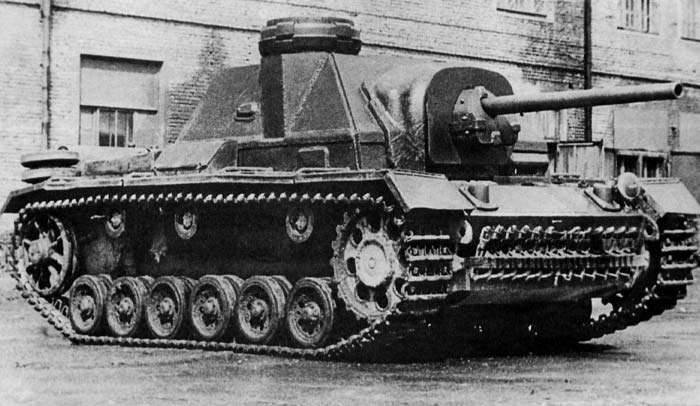
Initially, the SAU, created on the basis of trophies, was planned, by analogy with the SU-76, to arm the 76,2-mm cannon ZIS-3Sh. But in the case of the use of this tool, the embrasure of the tool was not reliably protected from bullets and shrapnel, since during lifting and turning of the tool in the shield there were always cracks. In this case, the special self-propelled 76,2-mm C-1 gun turned out to be an incident. Previously, it was created on the basis of the tank F-34, especially for light experienced SAUs of the Gorky Automobile Plant. The angles of vertical guidance of the gun from - 5 to 15 °, horizon - ± 10 ° in the sector. Ammunition was 98 shells. On commander vehicles, due to the use of a more cumbersome and powerful radio station, the ammunition was reduced.
Production of the car continued from March to November 1943. SU-76I, built in the amount of about 200 copies, despite the best security compared to SU-76, did not fit the role of light PT SAU. The practical rate of fire of the weapon was no more than 5 - 6 shots / min. And according to the characteristics of armor penetration, the C-1 gun was completely identical to the tank F-34. However, several cases of successful use of the SU-76I against medium-sized German tanks have been documented. The first cars began to arrive in the troops in May 1943, that is, several months later, SU-76, but unlike the Soviet self-propelled guns did not cause any complaints. They liked SU-76I troops, self-propelled guns noted high reliability, ease of operation and abundance of monitoring devices compared to SU-76. Moreover, in terms of mobility on rough terrain, the self-propelled gun was almost as good as the T-34 tanks, surpassing them in speed on good roads. Despite the presence of an armored roof, the crews liked the relative space inside the fighting compartment compared to other Soviet self-propelled artillery mounts, the commander, gunner, and loader in the conning tower were not too constrained. As a significant drawback was noted the difficulty of starting the engine in a severe frost.
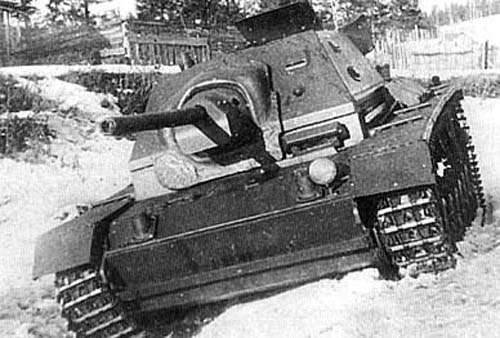
Self-propelled artillery regiments armed with SU-76I received baptism of fire during the Battle of Kursk, where they generally performed well. In July 1943, according to the experience of combat use, on the mask of the Su-76I gun was installed an armored reflective shield to prevent the gun from jamming by bullets and shrapnel. To increase the power reserve, SU-76I began to be equipped with two external petrol tanks mounted on easy-release brackets along the stern.
SU-76I self-propelled units were actively used during the Belgorod-Kharkiv operation, while many vehicles that received combat damage were repaired several times. In the army SU-76I met until the middle of the 1944 year, after which the survivors of the fighting machines were written off due to the limiting wear and lack of spare parts.
In addition to 76-mm guns, they tried to place an X-NUMX-mm howitzer M-122 on the captured chassis. Known about the construction of several machines under the name SG-30 "Artsturm" or abbreviated SG-122A. This self-propelled gun was created on the basis of the assault gun StuG III Ausf. C or Ausf. D. It is known about the 122 SAU order in September 10 of the year, but information on whether this order has been completely fulfilled has not been preserved.
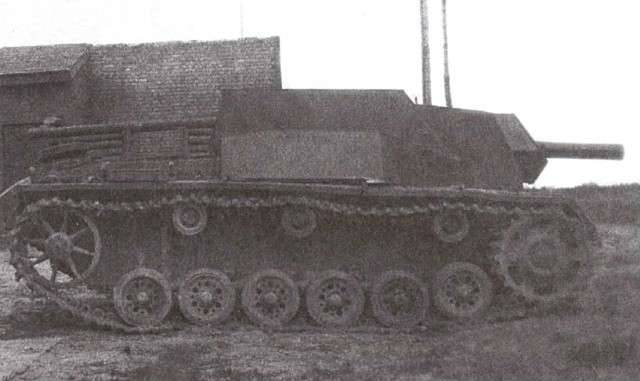
The 122-mm howitzer M-30 could not be installed in the standard German cabin. The conning tower of Soviet manufacture was significantly higher. The thickness of the frontal armor of the cabin is 45 mm, the sides are 35 mm, the stern is 25 mm, the roofs are 20 mm. The car was not too successful, experts noted excessive congestion of the front rollers and high gas content of the fighting compartment when firing. The ACS on the trophy chassis, after the Soviet-made armored car was installed, turned out to be cramped and had a weaker booking than the German StuG III. The absence at that time of good sighting devices and observation devices also adversely affected the combat characteristics of self-propelled guns. It can be noted that in addition to the alteration of trophies in the Red Army in 1942-1943, a lot of captured German armored vehicles were used unchanged. So, on the Kursk Bulge, trophy SU-34 (StuG III) and Marder III fought alongside the T-75.
Self-propelled SU-122, built on the chassis of the Soviet T-34 tank, turned out to be more viable. The total number of parts borrowed from the tank was 75%, the remaining parts were new, specially made for self-propelled installation. In many ways, the emergence of the SU-122 is associated with operating experience in the troops of captured German "artturm". The assault guns were much cheaper than tanks, the spacious logging allowed the installation of larger-caliber guns. Using the M-122 30 mm howitzer as a weapon promised a number of significant benefits. This weapon could be placed in the conning gear of the SAU, which was confirmed by the experience of creating the SG-122A. Compared with 76-mm projectile, howitzer 122-mm high-explosive fragmentation projectile had a significantly greater destructive effect. The 122-mm projectile, which weighed 21,76 kg, contained 3,67 explosives, versus 6,2 kg of the three-inch projectile with 710 gr. explosives. With a single shot of the 122-mm gun, more could be achieved than with a few shots of the 76-mm. The powerful high-explosive effect of the 122-mm projectile made it possible to destroy not only wooden-earthen fortifications, but also concrete bunkers or solid brick buildings. For the destruction of highly fortified cumulative shells could also be successfully used.
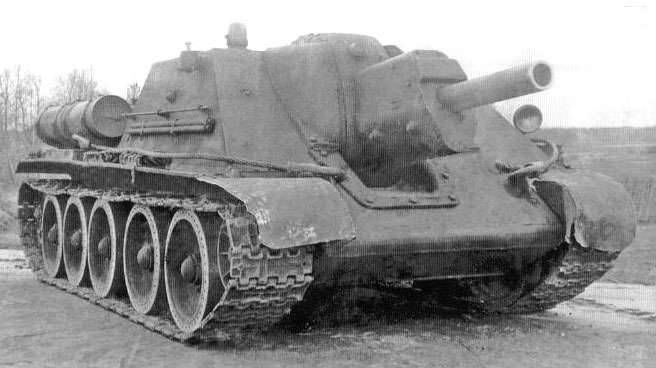
The SU-122 ACS was not born from scratch, at the end of 1941, the concept of a turretless tank was proposed with full preservation of the T-34 undercarriage armed with an 76-mm cannon. The weight savings achieved as a result of the abandonment of the tower made it possible to increase the thickness of the frontal armor to 75 mm. The complexity of manufacturing was reduced by 25%. In the future, these developments were used to create 122-mm ACS.
In terms of security, SU-122 practically did not differ from T-34. The ACS was armed with a tank modification of a 122-mm divisional howitzer arr. 1938 g. - M-30С, with preservation of a number of features of the towed gun. Thus, the placement of control organs for the guidance mechanisms on opposite sides of the barrel required the presence of two gunners in the crew, which, of course, did not add free space in the self-propelled gun. The range of elevation angles ranged from −3 ° to + 25 °, the sector of horizontal shelling ± 10 °. The maximum range of shooting - 8000 meters. Rate of Fire - 2-3 rds / min. Ammunition from 32 to 40 shots of separate-cartridge loading, depending on the series of release. These were mainly high-explosive fragmentation projectiles.
The need for such machines at the front was enormous, despite a number of observations revealed during the tests, they adopted an armament. The first regiment of self-propelled guns SU-122 formed at the end of the year 1942. On the front 122-mm ACS appeared in February 1943, and were received with great enthusiasm. Combat tests of self-propelled guns with the aim of practicing tactics of application were held in early February 1943. The most successful option is to use the SU-122 to support the advancing infantry and tanks, being behind them at a distance of 400 — 600 meters. During the breakthrough of the enemy defense, self-propelled guns with fire from their guns carried out the suppression of enemy firing points, destroyed obstacles and barriers, and also reflected counterattacks.
When hit 122-mm high-explosive projectile in an average tank, as a rule, it was destroyed or incapacitated. According to reports of German tankers who took part in the battle of Kursk, they repeatedly recorded cases of serious damage to heavy tanks Pz. VI "Tiger" as a result of shelling 122-mm howitzer shells.
This is what Major Homille writes in this connection with Commander III. Abteilung / Panzer Regiment Tank Division Grossdeutschland:
In general, assessing the anti-tank capabilities of the SU-122, it can be stated that they were very weak. This, in fact, served as a result of one of the main reasons for the withdrawal of ACS from production. Despite the presence in the ammunition cumulative shells of BP-460A 13,4 kg mass, with 175 mm armor penetration, it was possible to get into a moving tank from the first shot only from an ambush or in combat conditions in the locality. A total of 638 machines were built, the production of ACS SU-122 was completed in the summer of 1943. However, several self-propelled guns of this type survived to the end of hostilities, taking part in the storming of Berlin.
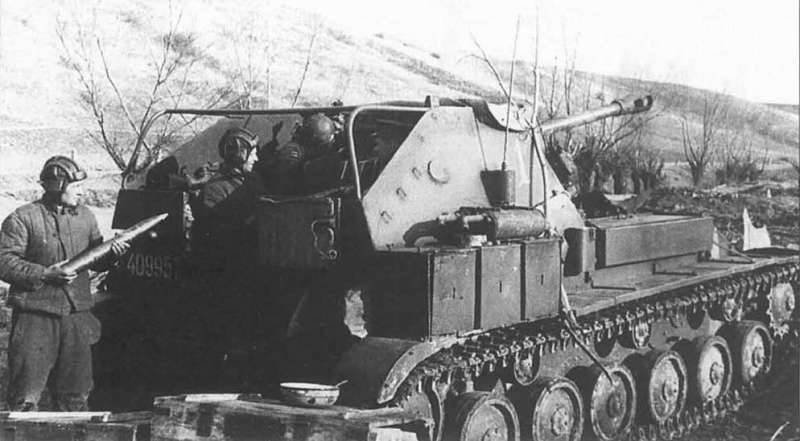
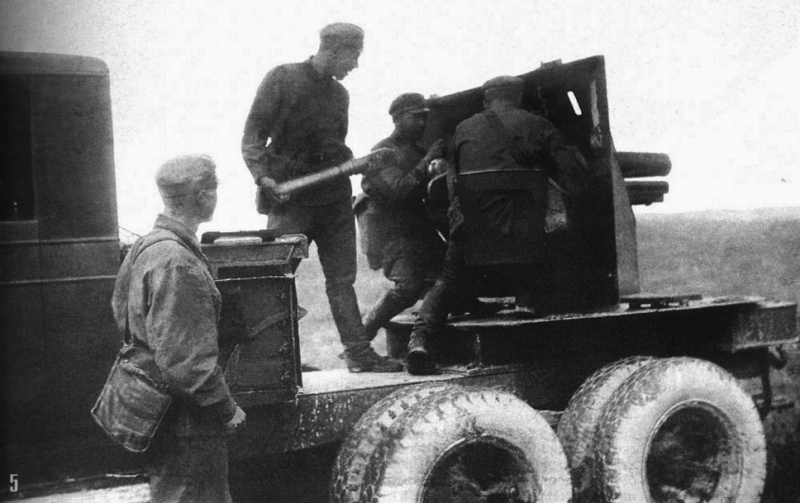
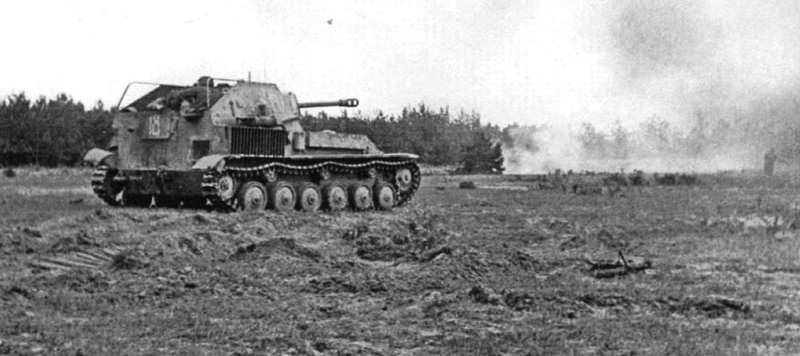
Information